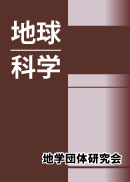All issues

Volume 61 (2007)
- Issue 6 Pages 427-
- Issue 5 Pages 333-
- Issue 4 Pages 235-
- Issue 3 Pages 171-
- Issue 2 Pages 101-
- Issue 1 Pages 1-
Volume 61, Issue 3
Displaying 1-10 of 10 articles from this issue
- |<
- <
- 1
- >
- >|
-
Atsushi URABE, Keiko TAMURA, Kouji SUZUKI, Noubyuki TAKAHAMAArticle type: Article
2007Volume 61Issue 3 Pages 171-172
Published: May 25, 2007
Released on J-STAGE: May 16, 2017
JOURNAL FREE ACCESSDownload PDF (855K) -
Akira SUGIYAMAArticle type: Article
2007Volume 61Issue 3 Pages 173-174
Published: May 25, 2007
Released on J-STAGE: May 16, 2017
JOURNAL FREE ACCESSDownload PDF (1116K) -
Shigeki CHIBA, Hiroshi SATOArticle type: Article
2007Volume 61Issue 3 Pages 175-177
Published: May 25, 2007
Released on J-STAGE: May 16, 2017
JOURNAL FREE ACCESSDownload PDF (1483K) -
Tatsuo UCHIZONOArticle type: Article
2007Volume 61Issue 3 Pages 179-186
Published: May 25, 2007
Released on J-STAGE: May 16, 2017
JOURNAL FREE ACCESSThe electric conductivity measured and water analysis of alluvial clays of the Nohbi Plain by the electric conductivity methods. The results are as follows; 1) This observation indicates that the Noted depends on anions with the electric conductivity measurement. 2) Correlation on electric conductivity and diatom analysis of sedimentary environment confirmation with good effective sedimentary environmental of judged to indexical in whether marine or non-marine; the Setup in the boundary between fresh water sediments and brackish sediments 60mS/m in electric conductivity, and the boundary between brackish sediments and marine sediments 150mS/m.View full abstractDownload PDF (1125K) -
Keiji NAKAZAWAArticle type: Article
2007Volume 61Issue 3 Pages 187-201
Published: May 25, 2007
Released on J-STAGE: May 16, 2017
JOURNAL FREE ACCESSThe Permian Akasaka Limestone in Oogaki City, Central Japan yields many fusuline fossils together with other macrofossils such as brachiopods, molluscs, corals, crinoids, calcareous algae and others. It is very famous that giant specimens of brachiopods, cephalopods, gastropods and bivalves are found from black, bituminous limestones of the Middle and the Upper Members. It is a noticeable fact that very small specimens of gastropods and bivalves are also found from thin-bedded black, muddy shell-limestone inserted in medium- to thick-bedded Yabeina biomicrite. They have been obtained from weathered soil of muddy layer of shell-limestone by repeated washing and sieving. Unlike the large specimens they have not been fully described. Among them bivalve fossils are reported in the present article. Four species could be identified, that is, Nuculopsis sp., Grammatodon (Cosmetodon) obsoletiformis (Hayasaka), Scaldia? sp. ind., and "Vacunella" sp. ind. It is concluded that they were transported from a shallower environment into a subtidal lagoonal place by mud flow presumably caused by storm. The results of reexamination on the ever-described bivalves are also mentioned. New species name, terukoae for Pernopecten sp. ind. Yamada (1995) is proposed.View full abstractDownload PDF (5925K) -
Shigeki CHIBA, Hiroshi SATOArticle type: Article
2007Volume 61Issue 3 Pages 203-208
Published: May 25, 2007
Released on J-STAGE: May 16, 2017
JOURNAL FREE ACCESSThe detailed records of the eruption of Bandai volcano on July 15^<th> in 1888 are kept in Sekiya and Kikuchi (1890). The photos taken immediately after the eruption were by Iwata Zenbei, Endo Rikurou and W.K.Burton et al. Some of them by Endo have been well known for many years but the others began to be discovered around 1988, just 100 years after its eruption Iwata's photos were discovered in 1987, then photos owned at the Imperial House hold Agency ("Meiji no Nihon" by Takebe and Nakamura 2000) were found in 2000, and photos possessed at the National Science Museum, Tokyo were discovered in 2001. "Meiji no Nihon" has the list of photos owned at the IHA and notes that the IHA had 21 photos of Bandai's eruption in 1888. Only 9 photos of them however are shown in the book. Therefore, all the 21 photos, 10 of which are unlisted, are recopied and carried in the thesis of ours with the permission of the IHA. This thesis has shown the photos of the eruption of Bandai volcano in 1888, including the unlisted photos. Those photos have been analyzed and considered the places, directions and present scenery of them. On top of that, a suffered house in one of the recorded photos is assured to exist today and its scenes of the past and present are compared and examined.View full abstractDownload PDF (3001K) -
Hidetoshi KAMIYAArticle type: Article
2007Volume 61Issue 3 Pages 209-216
Published: May 25, 2007
Released on J-STAGE: May 16, 2017
JOURNAL FREE ACCESSDownload PDF (3064K) -
Yasumoto SUZUKIArticle type: Article
2007Volume 61Issue 3 Pages 217-221
Published: May 25, 2007
Released on J-STAGE: May 16, 2017
JOURNAL FREE ACCESSDownload PDF (1104K) -
Akira SUGIYAMAArticle type: Article
2007Volume 61Issue 3 Pages 223-232
Published: May 25, 2007
Released on J-STAGE: May 16, 2017
JOURNAL FREE ACCESSDownload PDF (2279K) -
Article type: Bibliography
2007Volume 61Issue 3 Pages 234-
Published: May 25, 2007
Released on J-STAGE: May 16, 2017
JOURNAL FREE ACCESSDownload PDF (36K)
- |<
- <
- 1
- >
- >|